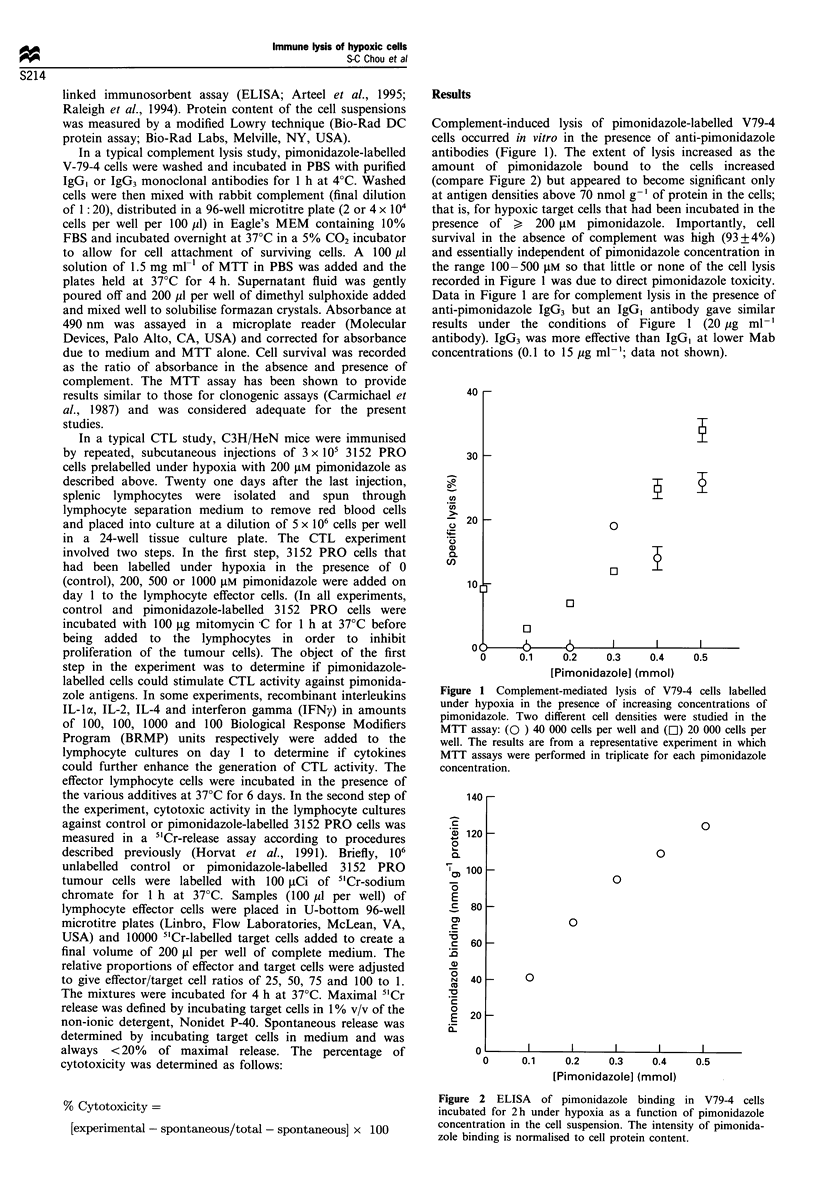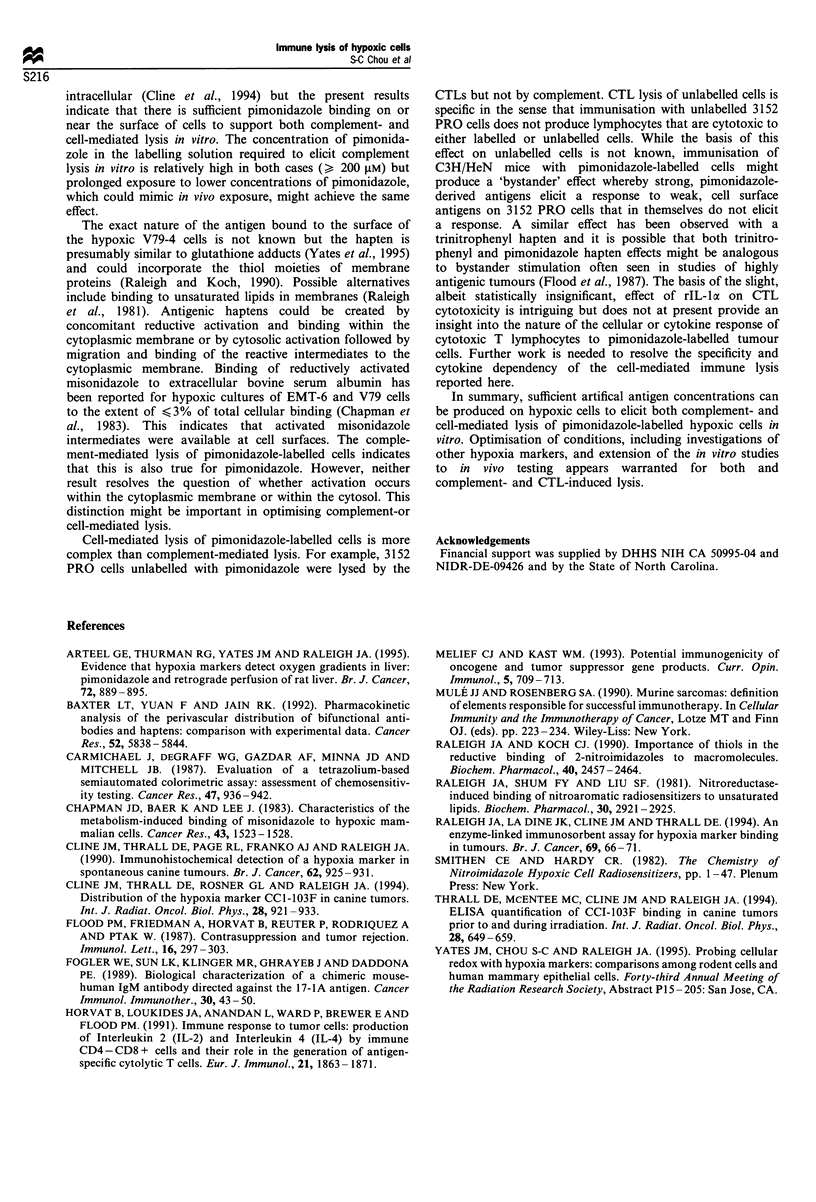Abstract
Artificial antigens are created when 2-nitroimidazoles bind to hypoxic cells. These antigens have been used in the immunodetection of tumour hypoxia but they might also serve to stimulate immune lysis of hypoxic tumour cells by complement- and cell-mediated processes. In order to test this hypothesis, lymphocytes isolated from the spleens of C3H/HeN mice that had been immunised with pimonidazole-labelled 3152-PRO cells were subcultured and tested for their ability to lyse chromium-51 loaded, pimonidazole-labelled 3152-PRO cells in an in vitro assay. In a parallel study, commercially available, rabbit complement was tested for its ability to lyse pimonidazole-labelled V79-4 cells in the presence of monoclonal antibodies which recognise protein adducts of reductively activated pimonidazole. Complement-mediated cell lysis was measured by means of an MTT assay. Complement-mediated and cell-mediated lysis was observed at pimonidazole concentrations which, in themselves, do not produce cell killing.
Full text
PDF



Selected References
These references are in PubMed. This may not be the complete list of references from this article.
- Arteel G. E., Thurman R. G., Yates J. M., Raleigh J. A. Evidence that hypoxia markers detect oxygen gradients in liver: pimonidazole and retrograde perfusion of rat liver. Br J Cancer. 1995 Oct;72(4):889–895. doi: 10.1038/bjc.1995.429. [DOI] [PMC free article] [PubMed] [Google Scholar]
- Baxter L. T., Yuan F., Jain R. K. Pharmacokinetic analysis of the perivascular distribution of bifunctional antibodies and haptens: comparison with experimental data. Cancer Res. 1992 Oct 15;52(20):5838–5844. [PubMed] [Google Scholar]
- Carmichael J., DeGraff W. G., Gazdar A. F., Minna J. D., Mitchell J. B. Evaluation of a tetrazolium-based semiautomated colorimetric assay: assessment of chemosensitivity testing. Cancer Res. 1987 Feb 15;47(4):936–942. [PubMed] [Google Scholar]
- Chapman J. D., Baer K., Lee J. Characteristics of the metabolism-induced binding of misonidazole to hypoxic mammalian cells. Cancer Res. 1983 Apr;43(4):1523–1528. [PubMed] [Google Scholar]
- Cline J. M., Thrall D. E., Page R. L., Franko A. J., Raleigh J. A. Immunohistochemical detection of a hypoxia marker in spontaneous canine tumours. Br J Cancer. 1990 Dec;62(6):925–931. doi: 10.1038/bjc.1990.411. [DOI] [PMC free article] [PubMed] [Google Scholar]
- Cline J. M., Thrall D. E., Rosner G. L., Raleigh J. A. Distribution of the hypoxia marker CCI-103F in canine tumors. Int J Radiat Oncol Biol Phys. 1994 Mar 1;28(4):921–933. doi: 10.1016/0360-3016(94)90113-9. [DOI] [PubMed] [Google Scholar]
- Flood P. M., Friedman A., Horvat B., Reuter P., Rodriquez A., Ptak W. Contrasuppression and tumor rejection. Immunol Lett. 1987 Dec;16(3-4):297–303. doi: 10.1016/0165-2478(87)90161-1. [DOI] [PubMed] [Google Scholar]
- Fogler W. E., Sun L. K., Klinger M. R., Ghrayeb J., Daddona P. E. Biological characterization of a chimeric mouse-human IgM antibody directed against the 17-1A antigen. Cancer Immunol Immunother. 1989;30(1):43–50. doi: 10.1007/BF01665029. [DOI] [PMC free article] [PubMed] [Google Scholar]
- Horvat B., Loukides J. A., Anandan L., Brewer E., Flood P. M. Production of interleukin 2 and interleukin 4 by immune CD4-CD8+ and their role in the generation of antigen-specific cytotoxic T cells. Eur J Immunol. 1991 Aug;21(8):1863–1871. doi: 10.1002/eji.1830210813. [DOI] [PubMed] [Google Scholar]
- Melief C. J., Kast W. M. Potential immunogenicity of oncogene and tumor suppressor gene products. Curr Opin Immunol. 1993 Oct;5(5):709–713. doi: 10.1016/0952-7915(93)90125-c. [DOI] [PubMed] [Google Scholar]
- Raleigh J. A., Koch C. J. Importance of thiols in the reductive binding of 2-nitroimidazoles to macromolecules. Biochem Pharmacol. 1990 Dec 1;40(11):2457–2464. doi: 10.1016/0006-2952(90)90086-z. [DOI] [PubMed] [Google Scholar]
- Raleigh J. A., La Dine J. K., Cline J. M., Thrall D. E. An enzyme-linked immunosorbent assay for hypoxia marker binding in tumours. Br J Cancer. 1994 Jan;69(1):66–71. doi: 10.1038/bjc.1994.10. [DOI] [PMC free article] [PubMed] [Google Scholar]
- Raleigh J. A., Shum F. Y., Liu S. F. Nitroreductase-induced binding of nitroaromatic radiosensitizers to unsaturated lipids. Nitroxyl adducts. Biochem Pharmacol. 1981 Nov 1;30(21):2921–2925. doi: 10.1016/0006-2952(81)90253-7. [DOI] [PubMed] [Google Scholar]
- Thrall D. E., McEntee M. C., Cline J. M., Raleigh J. A. ELISA quantification of CCI-103F binding in canine tumors prior to and during irradiation. Int J Radiat Oncol Biol Phys. 1994 Feb 1;28(3):649–659. doi: 10.1016/0360-3016(94)90190-2. [DOI] [PubMed] [Google Scholar]


